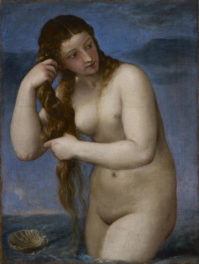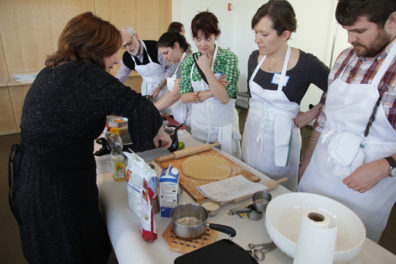All cultures create art. We crave that which unites us and binds us together like the pages of a well-made book. Art reminds us that we are part of something greater than ourselves. Books tell us why.
Writing a book is extremely difficult work. You have to come up with the story and all the words you want to say in the right order, and put it all together on the page… It can take years. Today we use computers for word processing and writing books. Now imagine writing a book by hand. No spellcheck. No ability to backspace. No undo. No cutting and pasting. That’s how they wrote books in the old days. If the thought of writing a book by hand, or even by typewriter, sounds like an exercise in futility, you might be like me—totally reliant on technology.
As a writer, books inspire me. And illuminated manuscripts, books written and decorated by hand, one stroke at a time, have my deepest respect and admiration, because writing a book by hand is perhaps the most difficult art work a person can do.
When I heard about the Getty Museum exhibition Traversing the Globe through Illuminated Manuscripts, I immediately planned a visit. Exploring medieval texts and manuscripts from around the world made it very clear to me: Books are art. Perhaps even the highest form of art, more than just words on a page, illuminated manuscripts are handcrafted, painstakingly created masterpieces. Meant to tell a story and pass down knowledge and wisdom to the future reader, a book is a work of art designed to open the mind, ignite the imagination, and create meaning in the mind of the reader. Books take us on a journey in a way few other mediums can… and this exhibition took me on an imaginary adventure like few others have. When you read into them, books are endlessly inspiring.
The Labor of Bookmaking
In the digital age, where text and pictures appear and vanish constantly, or in the age of mechanical reproduction, where books were printed by millions of copies, it’s easy to forget how difficult it once was just to make a book. A blank manuscript to write a story in could take days, weeks, or even months to make! If scribes go through that much effort to create a blank book, they surely would want to fill the pages with only what is worthwhile and lasting. In the exhibition, I saw how the writers and artisans of the past did just that—they filled the pages with literal gold.

An gilded and ornamented parchment manuscript on display in Traversing the Globe through Illuminated Manuscripts
Suitable, durable writing material was not easy to produce in pre-modern times. To make what we think of today as “paper,” one had to pound papyrus or wood bark into a pulp, and then press it into sheets. Alternatively, one could treat and stretch the skin of animals into parchment. Bookmaking was an art and science in itself, as the papers were cut and bound together in increasingly complex manners and styles. If you had to use the skins of dead animals as paper, you would likely feel the pressure to be very careful not to make any mistakes. When I admired the manuscripts on display, I got the feeling the writers worked extremely hard to make the books beautiful in every way possible. They wrote books in a way very different than we do today.
Visual Storytelling
Manuscripts tell the stories our ancestors wished to be shared, disseminated the world over, and never forgotten. The illuminated manuscripts on display were incredible, awe inspiring, and magical to me. Painted in gold and bright hues—let’s not even go into how difficult it was to get gold or the color purple or ancient times—these illustrations sparked my imagination. Unlike mechanically produced texts, books written by hand speak to the reader in a much more visceral, deeper, and more meaningful way. Handwriting and subtle changes in copied text give us clues to the mind of the writer.
As a writer, words are my art. Diligently and punctiliously handwritten, often over a period of years, illuminated manuscripts speak to me of the dedication and reverence people had for the written word and for language, and for its ability to change and create history and culture. Books give us what nothing else from ancient times can: direct experience and wisdom.

Among the treasures on view in Traversing the Globe: Iskandar at the Kaaba (detail), leaf from a manuscript of the Khamsa, about 1485–95, unknown artist, made in Shiraz, Iran. Los Angeles County Museum of Art. From the Nasli M. Heerameneck Collection, gift of Joan Palevsky. Image: www.lacma.org

The Adoration of the Magi from the Prayer book of Cardinal Albrecht of Brandenburg, about 1525–30, Simon Bening. Tempera colors, gold paint, and gold leaf on parchment, 6 5/8 × 4 1/2 in. The J. Paul Getty Museum, Ms. Ludwig IX 19, fol. 36v
A Meeting of Minds
As a philobiblist (nerdy book lover!), I also enjoy learning, and I’ve found that one of the best ways to learn is by gathering together people with a common interest to share and exchange wisdom. This spring I had the great pleasure of attending the Manuscripts in a Global Context symposium held in conjunction with the exhibition. I left the day-long event with an even greater love of manuscripts and a much better understanding of their history. I’m thankful to the curators at the Getty Museum for organizing this event, and look forward to attending more events and lectures in the future!
Sparking Inspiration
The Getty and its exhibitions have been so inspiring to me and my own artistic journey. I felt I wanted to share my story in case it touches others. If you like books and are anywhere near Los Angeles, I urge you to see Traversing the Globe through Illuminated Manuscripts at the Getty. I guarantee you’ll be inspired.
Text of this post © Julian Tyler. All rights reserved.
Have you been inspired by the art, architecture, gardens, or people of the Getty? Share your creativity on our #GettyInspired website gallery.

See all posts in this series »





Comments on this post are now closed.